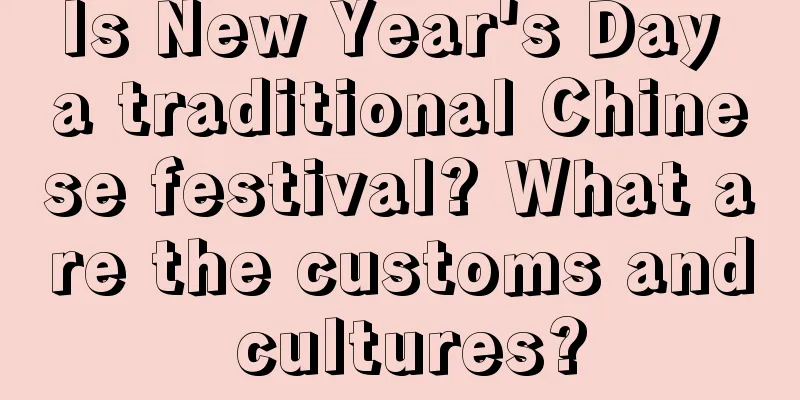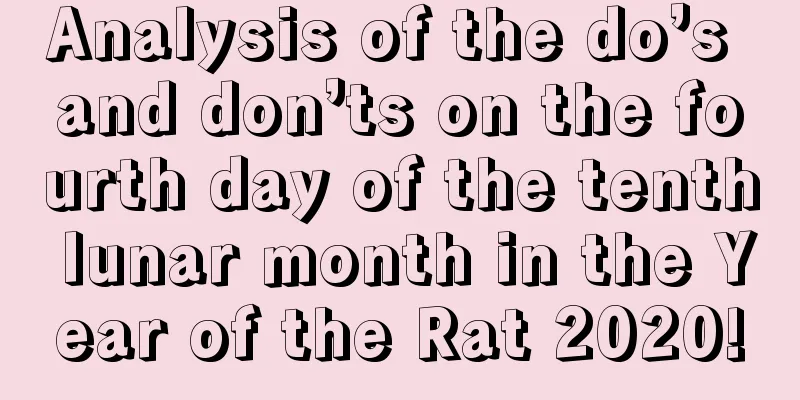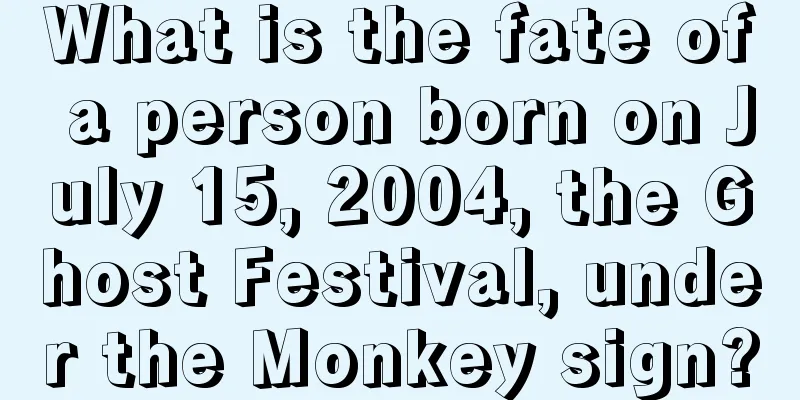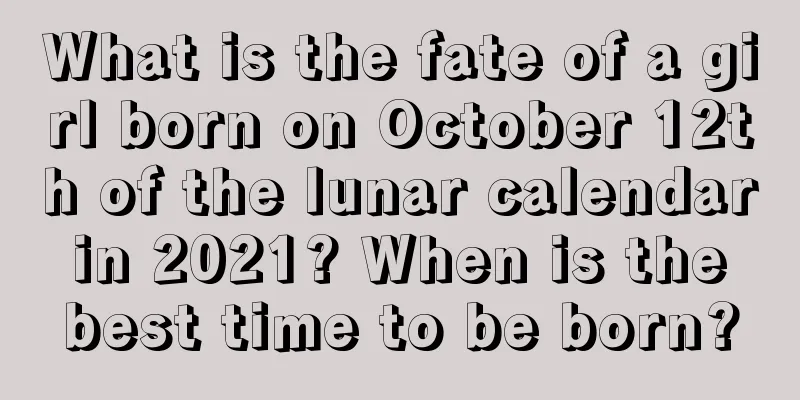Is New Year's Day a traditional Chinese festival? What are the customs and cultures?

Chinese traditional festivals have a long history of development in human history, and have rich and colorful content and forms, as well as profound cultural heritage. All of these demonstrate the long history and profoundness of Chinese national culture. So the question is, is New Year's Day a traditional Chinese festival? What are the customs and cultures? The Western Christmas is coming soon in the eleventh month of the lunar calendar. Do you know whether Christmas Day will be auspicious or inauspicious? Let Mr. Shui Mo analyze the daily fortunes of November 2020 in the lunar calendar for you.Is New Year's Day a traditional Chinese festival?Does not belong.The "New Year's Day" we are talking about today was on September 27, 1949, when the First Plenary Session of the Chinese People's Political Consultative Conference decided to establish the People's Republic of China and also decided to adopt the world-wide Gregorian calendar. January 1 of the Gregorian calendar was officially designated as "New Year's Day" and the first day of the first lunar month was changed to "Spring Festival". When did the ancient Chinese New Year's Day originate?According to legend, China's New Year's Day originated from Zhuanxu, one of the Three Sovereigns and Five Emperors, and has a history of more than 3,000 years.The word "New Year's Day" first appeared in the poem "Book of Jin": "Emperor Zhuanxu took the first month of summer as the beginning, which was actually the spring of the New Year's Day." During the Northern and Southern Dynasties, there was a record in the poem "Jie Ya" by Xiao Ziyun of the Southern Dynasty: "Four seasons new New Year's Day, longevity in the early spring." China first called the first day of the first lunar month "New Year's Day". Yuan means "beginning" or "beginning", and Dan means "day". New Year's Day means "the first day", which is the first day of the year. Before Emperor Wu of Han, there was no unified definition of the date for the first day of the first lunar month. Therefore, the month and day of New Year's Day are not consistent throughout the ages. The Xia calendar of the Xia Dynasty took the first month (January) as the first month, the Yin calendar of the Shang Dynasty took the twelfth month (December) as the first month, and the Zhou calendar of the Zhou Dynasty took the eleventh month (November) as the first month. After Qin Shi Huang unified China, he took the Yangchun month (October) as the first month, and the first day of October as New Year's Day. It was not until Emperor Wu of the Han Dynasty that the first month of the lunar calendar was designated as the first lunar month, and the first day of the first lunar month (the first day of the first lunar month in the lunar calendar) was called New Year's Day, which was used until the end of the Qing Dynasty. But this is the Xia calendar, also known as the lunar calendar or the lunar calendar, not what we call New Year's Day today. What are the customs and cultures of New Year’s Day?•Ancient New Year's Day customs•Food is the most important thing for people. In ancient China, after harvesting the crops and working hard for a year, people would prepare rich food to welcome the spring, which is called "the year when all the grains are ripe", commonly known as "New Year". There are records of setting off firecrackers, attending annual meetings, and having reunion dinners as early as the Song Dynasty. In the Northern Song Dynasty, Lü Yuanming's "Miscellaneous Notes on the Seasons" mentioned: "On New Year's Day, many people in the capital eat noodles, the so-called Nian 馎馎, or something like this." This shows that the people of Bianliang at that time would prepare food such as noodles to celebrate the New Year. The customs of New Year's Day gradually took shape. •New Year's Day customs after the founding of New China• After the founding of New China, the First Plenary Session of the Chinese People's Political Consultative Conference decided that my country would adopt the Gregorian calendar, and New Year's Day is the Gregorian New Year. New Year’s Day is a three-day holiday, and it has become one of the important festivals in our country. The joy of New Year's Day continues until the Lunar New Year. Reunion, ancestor worship, eating dumplings and appreciating lanterns have become the habits of every Chinese citizen and every family to celebrate the New Year. •New Year's Day customs in the north• The weather in northern my country is cold in winter, with short days and long nights. Starting from New Year's Day, people who are not busy on the farm would slaughter pigs and sheep, sit cross-legged on the earthen kang, and chat about family matters. They would not work or go out, and the process would end on the fifteenth day of the first lunar month. Due to the cold weather, the New Year's Day diet in Northeast China mainly consists of frozen foods, pickled vegetables, and stews. Frozen dumplings, sauerkraut stewed with vermicelli, pickled snow mustard greens, etc. are all must-have foods for New Year's Day. Children in Beijing eat candied haws during the New Year, which symbolizes a prosperous new year. In terms of culture and customs: Yangko dancing, stilt walking, and Northeast Errenzhuan will all be performed in succession at the temple fair. In Tianjin, people are busy cutting window flowers, pasting couplets, and engaging in a myriad of other cultural and entertainment activities. On New Year's Day, students in Shandong burn incense and worship the statue of Confucius in the hope of getting their names on the imperial examinations next year. •New Year's Day customs in the south• Compared with the "vulgar" New Year's Day customs in the north, the New Year's Day customs in the south tend to be "elegant". In the Jiangsu and Zhejiang areas, bamboo poles are tied to grass and set on fire during New Year's Day, which is called "celebrating the silkworms in the fields." On New Year's Day in Shaoxing, guests are entertained with "tea bowl tea", and some people also put olives and kumquats in it, which is called "holding ingots". In Fujian, the Minnan pronunciation of "spring" and "leftover" is the same. When eating on New Year's Day, people put flowers made of red paper on the rice, which is commonly known as "spring rice". Spring dinner is a symbol of "abundance every year". In Guangdong, when paying New Year’s greetings on New Year’s Day, the elders will give red envelopes or tangerines to the younger generations as rewards, which is also a symbol of good luck and surplus in the coming year. •Taiwan New Year's Day customs• In Taiwan, the beautiful island, the whole family, young and old, gathers together for a meal on New Year’s Day, with hot pot on the table. This is called "sitting around the fire." Those who participate in the "fireside gathering" must taste every dish on the table and drink a symbolic amount of wine to pray for prosperity in the coming year. On New Year’s Day, Taiwanese compatriots will eat long-term dishes. The so-called long-lived vegetable is actually what is commonly known as mustard greens. Taiwanese people believe that the long leaves of this vegetable symbolize long life. Some people add vermicelli when cooking, which symbolizes continuity and immortality. •Tibetan New Year's Day customs• During the Tibetan New Year, every family will put up "Zhoso Chema" and insert colorful flowers made of butter on it, praying for a good harvest in the coming year. Women make "Kasai", a pastry made with ghee, to entertain guests. The windows are replaced with new curtains, the beams and kitchens are decorated with Hada, and the herdsmen, who are good at singing and dancing, sing and dance around the bonfire, creating a festive atmosphere. Summary: Every hundred miles has different customs, and every thousand miles has different customs. There are many other customs for New Year's Day. Our motherland is vast and rich in resources, and the customs of New Year's Day vary from place to place in the country. These different customs come together to form a common gift to welcome the new year. This is a symbol of the great integration of China's 56 ethnic groups. |
<<: Is it a good time to travel on January 1, 2021? Analysis of the name of New Year's Day
Recommend
Is it okay to sign the contract on December 28th of the lunar calendar in the Gengzi Year of 2020? Is it an auspicious day?
Is it okay to sign the contract on December 28th o...
What is the position of the God of Wealth on June 17, 2020? Where is the God of Wealth at different times?
June is also known as the hottest month of the ye...
The position of the God of Wealth on the eighth day of the fifth lunar month in 2020, and the Feng Shui of placing the God of Wealth
The position of the God of Wealth on the eighth d...
Baby names for those born in June of the Year of the Dog
What kind of name can a baby born in June with the...
Is it suitable to set up a bed on the first day of the fifth lunar month in 2022? Are there any Feng Shui taboos?
The fifth month of the lunar calendar is also call...
Is the 20th day of the seventh lunar month in 2021 a good day? Is it a good day to get a haircut?
Autumn begins in the seventh month of the lunar ca...
Is June 13th of the leap lunar calendar in 2017 a good day to open a store? Is the opening going well?
Introduction: Everyone who opens a store hopes tha...
Is March 29th of the lunar calendar in 2018 suitable for traveling? How auspicious or inauspicious is the day and time?
Spring is the best time to travel. The blooming fl...
Is it a good time to offer sacrifices on December 16 of the lunar calendar in 2019? What will the hexagram look like on January 10, 2020?
Introduction: Generally, an auspicious day should ...
Is the eighth day of the eleventh lunar month in 2019 an auspicious day for moving?
Chinese people are particular about choosing an a...
Is April 11th of the lunar calendar 2018 a suitable date for opening a new store?
The fourth month of the lunar calendar marks the ...
What are the do's and don'ts on the 16th day of the first lunar month in 2022? Is it an auspicious day for opening a business?
The first month of the year is also known as the Y...
Analysis of the fate of a baby girl born on August 29th of the lunar calendar in 2019!
Destiny, that is, fate and luck, refers to a patte...
What is the best gift for Mother's Day?
Mother's Day is coming soon, and many people a...
How is the fortune of a girl born on May 20th of the lunar calendar in 2020? What is her zodiac sign when she was born today?
Introduction: A new life is born every day, so how...









